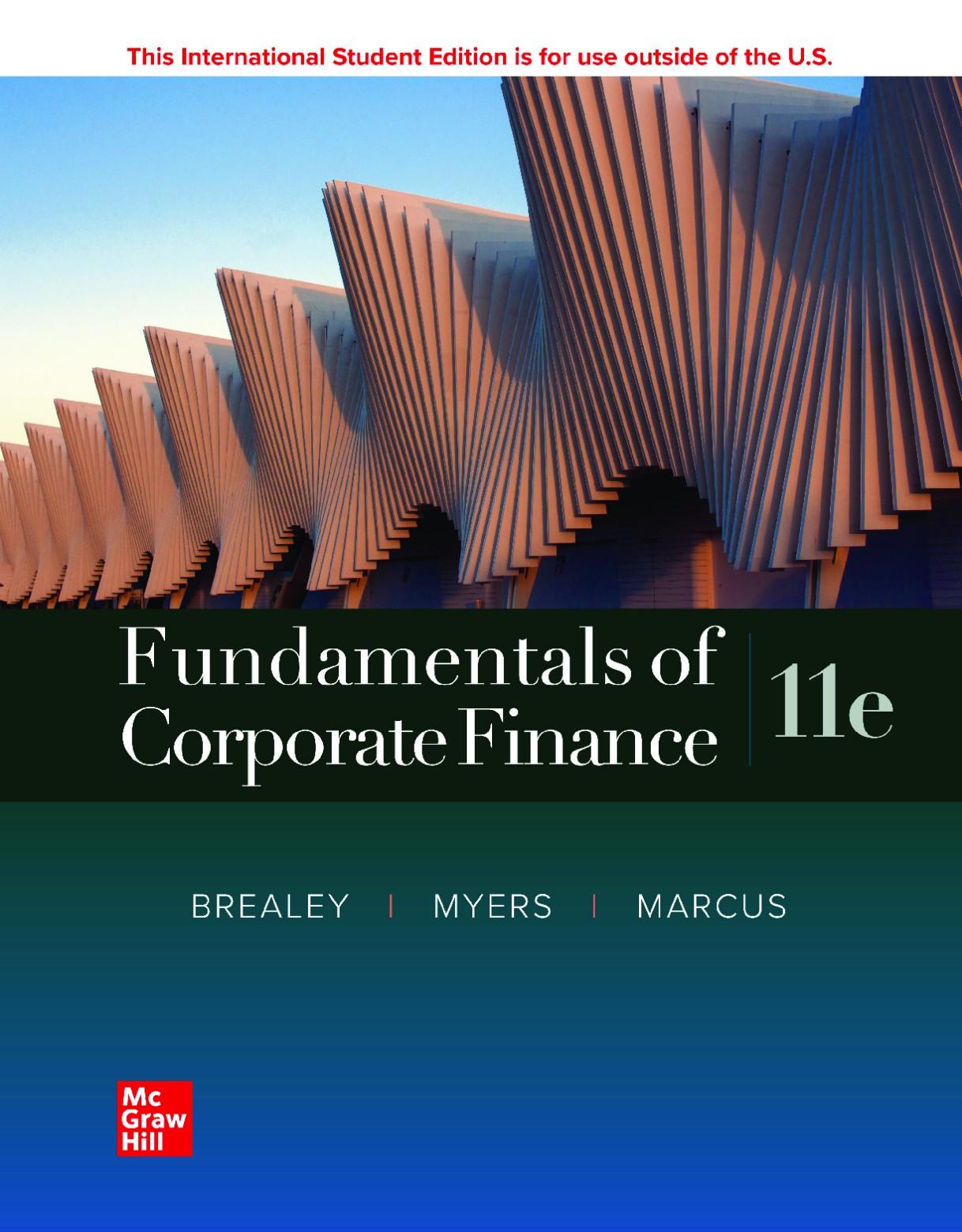
"Fundamentals of Corporate Finance" by Richard Brealey, Stewart Myers, and Alan Marcus is a comprehensive textbook that covers essential concepts in corporate finance. Below is a chapter-wise summary of the key topics:
Chapter 1: Introduction to Corporate Finance This chapter introduces the role of corporate finance and the financial manager. It outlines the three main areas of concern: capital budgeting (deciding on longterm investments), capital structure (determining the mix of debt and equity financing), and working capital management (managing short-term assets and liabilities).
Chapter 2: Financial Statements, Taxes, and Cash Flow Focuses on understanding financial statements, including the balance sheet and income statement. It discusses the importance of cash flow analysis and the impact of taxes on corporate finance decisions.
Chapter 3: Working with Financial Statements Explores techniques for analyzing financial statements, such as ratio analysis and the DuPont identity. It emphasizes the use of financial information in assessing a company's performance and financial health.
Chapter 4: Long-Term Financial Planning and Growth Discusses the process of financial planning and its role in supporting a firm's growth objectives. Topics include the percentage of sales approach, external financing needs, and sustainable growth rates.
Chapter 5: Introduction to Valuation: The Time Value of Money Introduces the concept of the time value of money, covering present and future value calculations, annuities, and perpetuities. These foundational concepts are crucial for valuing cash flows and making investment decisions.
Chapter 6: Discounted Cash Flow Valuation Builds on time value of money principles to value cash flows using discounted cash flow (DCF) analysis. It covers techniques for valuing different cash flow streams and applying DCF in various financial contexts.
Chapter 7: Interest Rates and Bond Valuation Examines the relationship between interest rates and bond prices. Topics include bond valuation, yield to maturity, bond ratings, and the factors influencing interest rates.
Chapter 8: Stock Valuation Focuses on valuing equity securities, discussing models like the dividend discount model and price-earnings ratios. It also covers market efficiency and the factors affecting stock prices.
Chapter 9: Net Present Value and Other Investment Criteria Explores various methods for evaluating investment opportunities, including net present value (NPV), internal rate of return (IRR), payback period, and profitability index. The chapter emphasizes NPV as the most reliable criterion.
Chapter 10: Making Capital Investment Decisions Delves into the practical aspects of capital budgeting, such as estimating cash flows, handling project interactions, and incorporating risk analysis into investment decisions.
Chapter 11: Project Analysis and Evaluation Discusses techniques for analyzing and evaluating projects post-implementation, including scenario analysis, sensitivity analysis, and break-even analysis.
Chapter 12: Some Lessons from Capital Market History Provides an overview of historical returns and risks associated with different asset classes. It introduces concepts like average returns, variance, and the importance of diversification.
Chapter 13: Return, Risk, and the Security Market Line Explores the relationship between risk and return, introducing the Capital Asset Pricing Model (CAPM) and the Security Market Line (SML) as tools for assessing expected returns based on systematic risk.
Chapter 14: Cost of Capital Discusses how firms determine their cost of equity, debt, and weighted average cost of capital (WACC). It highlights the importance of WACC in investment appraisal and corporate valuation.
Chapter 15: Raising Capital Covers the various methods firms use to raise capital, including public offerings, private placements, and venture capital. It also discusses the costs and regulatory considerations associated with different financing options.
Chapter 16: Financial Leverage and Capital Structure Policy Examines the impact of financial leverage on a firm's risk and return. Topics include the trade-offs between debt and equity financing, optimal capital structure, and the effects of financial distress.
Chapter 17: Dividends and Payout Policy Analyzes different dividend policies and their implications for shareholder value. It discusses factors influencing dividend decisions, stock repurchases, and the signaling effects of payout policies.
Chapter 18: Short-Term Finance and Planning Focuses on managing short-term assets and liabilities, including cash management, credit policies, and inventory control. It emphasizes the importance of liquidity and efficient working capital management.
Chapter 19: Cash and Liquidity Management Delves deeper into cash management strategies, discussing topics like cash collection, disbursement, and investing surplus cash. It also covers tools for managing liquidity effectively.
Chapter 20: Credit and Inventory Management Addresses the management of accounts receivable and inventory. It covers credit policy design, credit analysis, and inventory management techniques to optimize operational efficiency.
Chapter 21: International Corporate Finance Explores financial management in an international context, including exchange rate risk, political risk, and strategies for hedging foreign exposure.
Chapter 22: Behavioral Finance: Implications for Financial Management Introduces behavioral finance, examining how psychological factors and biases influence financial decision-making and market outcomes.
Chapter 23: Enterprise Risk Management Discusses the identification, assessment, and management of various risks faced by corporations. It covers tools and frameworks for implementing effective risk management practices.
Chapter 24: Options and Corporate Finance Introduces options and their valuation, discussing how firms can use options in corporate finance decisions, including real options analysis and executive compensation.
Chapter 25: Option Valuation Provides a deeper look into option pricing models, such as the BlackScholes model, and their applications in valuing corporate securities and investment opportunities.
Chapter 26: Mergers and Acquisitions Examines the financial and strategic considerations in mergers and acquisitions, including valuation methods, deal structuring, and the impact on shareholder value.
Chapter 27: Leasing Discusses leasing as an alternative to purchasing assets, covering the types of leases, accounting and tax implications, and the decision-making process for lease versus buy.
This structured overview encapsulates the core themes and topics presented in each chapter of the textbook, providing a foundational understanding of corporate
Get complete eBook Instant Download Link below https://scholarfriends.com/singlePaper/456344/ebookise-fundamentals-of-corporate-finance-11th-edition-byalan-marcus-richard-brealey-stewar
